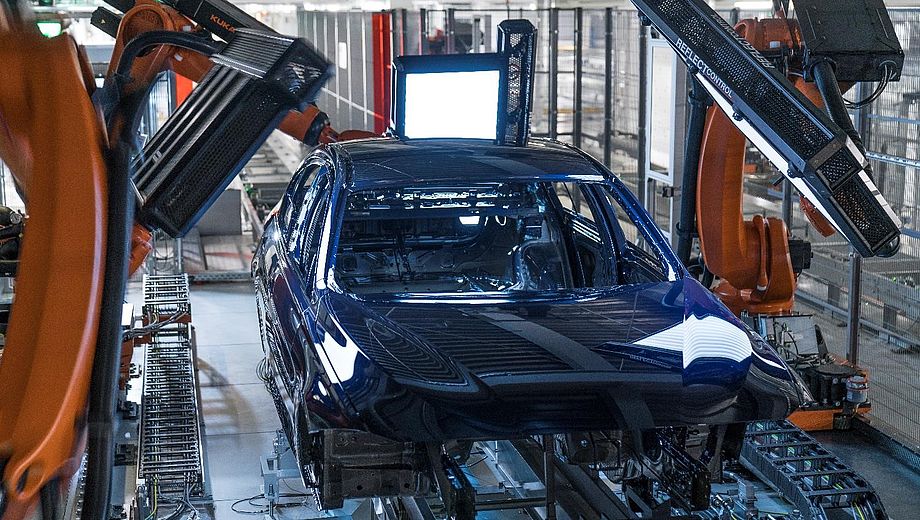Project KISSMe3D: On track to creating a self-learning measuring system

Micro-Epsilon Messtechnik GmbH & Co. KG, the University of Passau and Landshut University of Applied Sciences have pulled together to develop an innovative, AI-based method for the speedier development of sensors and systems that carry out optical 3D measurements and are able to optimise themselves without interrupting system operation.
To vet the seams of an airbag in a car's cockpit for the smallest of defects or to check the optical components of a lens, for example, you need high-precision technology. To date, measuring systems had to be meticulously re-designed for each new measurement task and optimised in exacting laboratory tests based on the size and nature of the individual object. But this is about to change: A research project was launched in August for the purpose of developing an innovative method that uses modelling and artificial intelligence to produce camera-based 3D measuring systems. The KISSMe3D project receives around EUR 1.24 million in funds from the Free State of Bavaria. In addition to the consortium leader Micro-Epsilon Messtechnik GmbH & Co. KG in Ortenburg, the project participants are Landshut University of Applied Sciences and the Institute for Software Systems in Technical Applications of Computer Science (FORWISS) of the University of Passau.
To deliver on this ambitious goal, the engineering knowledge and related experience needed to design and optimise such systems will be replicated in a computer. The plan is to use physical modelling methods, including those used for visualisation in video games, in combination with artificial intelligence. At KISSMe3D, this method will be available for a variety of measuring techniques, including light-sectioning, deflectometry for the measurement of reflective surfaces such as lenses and smartphone displays, and fringe projection for matt objects such as injection-moulded plastic parts. The procedure requires a laser, a screen and a projector. These three different light sources and the parameters of the cameras will now be described as realistically as possible on a PC so that the most suitable setup can be found "at the touch of a button" for each new measurement task. “This will allow us to speed up the development process considerably. The conceptual design, which currently can take anywhere from several weeks to months, will then be produced on the computer in a fully automated process," explains Professor Christian Faber, the project manager at Landshut University of Applied Sciences, who is mainly responsible for the physical modelling.
AI-based sensor learning
Using this method, the cameras, lenses, screen and projector can be modelled on the PC until a “digital twin” emerges. In practice, it will no longer be necessary to mount cameras. Computer simulation will make many of the steps redundant. At some point, however, efforts to make the modelling more precise will not longer be worth the while, especially with objects that have complex surface structures or in cases where a complex arrangement of sensor components is required. "That is where artificial intelligence comes into play," says Professor Tomas Sauer, project manager at the University of Passau. "Characteristics that can no longer be modelled will be captured as accurately a possible using machine learning. We now look forward to continuing our successful cooperation in machine learning." The smart system automatically optimises itself for the new measuring tasks – an enormous advantage for the manufacturing industry. The goal is to substantially reduce the setup time during commissioning and to assemble a perfect measuring system in a few quick steps that is able to re-calibrate itself and continues to adjust itself at the end customer's premises thanks to the automatic self-adapting sensor technology used.
For the project's practical implementation, wide-ranging competencies are required in the fundamentals of optics and physics, in AI methods, algorithmics and sensor technology, as well as an understanding of industrial requirements. The three project partners thus complement one another perfectly: while the focus at Landshut University of Applied Sciences is on modelling for optical metrology, the focus at the University of Passau is on AI development. The main tasks of Micro-Epsilon Messtechnik GmbH & Co. KG are to specify the application scenarios, provide suitable sensor components and set up the demonstrators.
"The company's core competencies are the performance of dimensional measurements using optical sensor technology and the development of complex sensor systems," explains Dr. Alexander Wisspeintner, managing director of Micro-Epsilon Messtechnik GmbH & Co. KG. "In successfully accomplishing the purpose of the funded project we will be setting an important foundation for our future product development. The project is thus an important stepping stone in our efforts to strengthen the competitiveness of the company and region in the global market."
About the project
The project "Modelling and Artificial Intelligence for Better Sensor Systems in 3D Measurement Technology (KISSMe3D) will be completed by January 2025. Micro-Epsilon Messtechnik GmbH & Co. KG in Ortenburg is consortium leader and represented by managing director Dr. Alexander Wisspeintner. Professor Tomas Sauer is the project managers at the Institute for Software Systems in Technical Applications of Computer Science (FORWISS) at the University of Passau and Professor Christian Faber is project manager at Landshut University of Applied Sciences.
A deflectometry system checks the painted surface of car bodies for tiny surface defects in automobile production. Photograph: BMW AG.
| Principal Investigator(s) at the University | Dr. rer. nat. Erich Fuchs (Institut für Softwaresysteme in technischen Anwendungen der Informatik (FORWISS Passau)), Prof. Dr. Tomas Sauer (Institut für Softwaresysteme in technischen Anwendungen der Informatik (FORWISS Passau)) |
|---|---|
| Project period | 01.08.2021 - 31.01.2025 |
| Source of funding | BayStMWi - Bayerisches Staatsministerium für Wirtschaft, Landesentwicklung und Energie |

